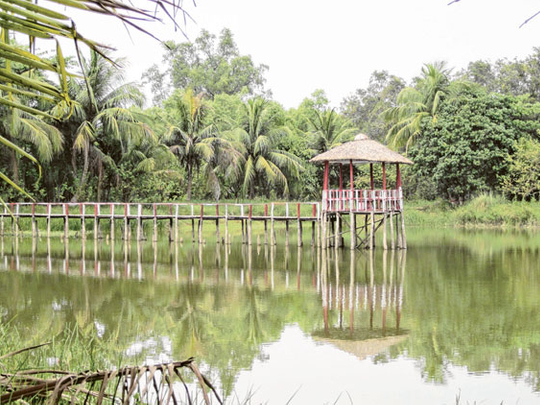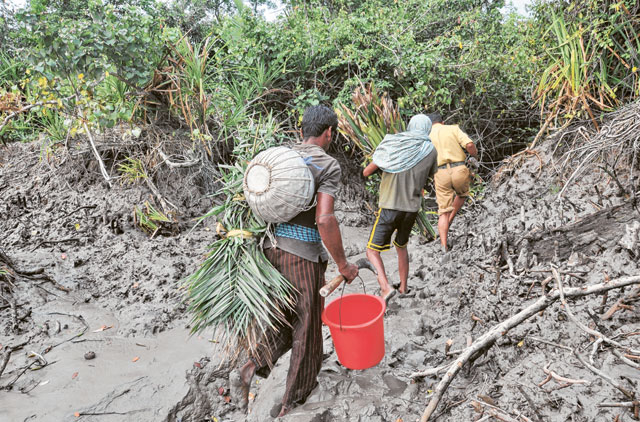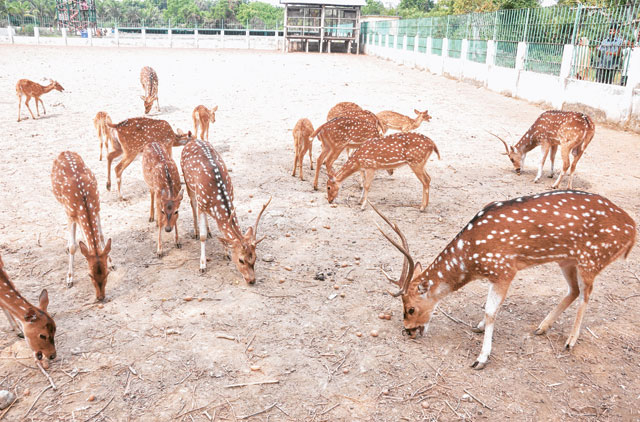
I wouldn't call myself much of a traveller or a thrill-seeker, and one needs to be both to enjoy the proliferous mangrove forest of Bangladesh. Nevertheless, the quiet, alluring charm of the largest mangrove forest in the world, coupled with the large range of wildlife I spotted in the course of a quick, day-long trip, have made both out of me.
The forest, which spans 5,772 square kilometres in southwest Bangladesh, besides a portion in India's West Bengal (approximately 38 per cent), is a Unesco World Heritage Site. For most tourists, the charm stems from the fact that it is one of the last remaining homes of the majestic Royal Bengal tiger.
This was perhaps all I knew as I set off on a whirlwind trip organised by the Ministry of Foreign Affairs, which intended to show a group of journalists the major attractions of this site. We flew to the capital city Dhaka via Etihad Airways and got to Khulna district via an eight-hour bus journey, and on our way to the small town of Mongla Port, we picked up the mandatory passes one needs to visit the Sunderbans. These passes also assign a forest guard or two to each delegation of tourists to the forests, for much-needed protection from wildlife.
Spotting the stripes
"Most visitors who stay for half a day won't spot a tiger, but if one does spot you and you appear to threaten its territory, you had better have a gun and an experienced forest guard with you," our tour guide said. Apparently, tigers are shy and solitary creatures, but once a tiger has to defend itself from a possible threat and has tasted human flesh, it becomes a "man-eater" that will only prey on humans.
As we began our day, I understood that getting through the forest, which has been deemed a wildlife sanctuary by the Bangladesh government, also means one has to use a large boat or a ferry. This is because the Sunderbans have no pathways running through them and are completely wild (the only human settlements are in the northern banks), and unless one is a complete adventure buff who prefers to walk through brambles and bushes in swampy mud, this is the only way to see the jungle. Acquiring the boat, however, is no real hassle: a range of affordable package tours are also available, providing groups of tourists with a boat that will travel through the rivers of the forest and stop at the main points of interest. Typically, a four-day, three-night package (including boat, forest guard, food and a place on a boat) costs a little more than $1,000 (Dh3,673) per person.
As we travelled through the major waterways on our boat, the Bono Rani (which means "Queen of the Jungle" in Bengali), I saw how intricately the rivers and their tributaries crisscrossed the Sunderbans. The tidal mangrove forest is located on the delta of the Ganges, Brahmaputra and Meghna rivers, all of which flow into the Bay of Bengal. But these are only the major rivers; numerous small tributaries flow throughout the forest.
One of the first sights I was offered was the chance to see inhabitants of nearby villages collecting honey from hives in the forest. These men usually row a small boat — a two-seater — and stop at certain areas and get the honey. However, this is no mean feat on their part, as the jungle is fraught with risks. The grounds are swampy and your legs sink almost halfway into the gooey, grey mud. And there is no road, so one has to push past brambles and trees that fill the forest. It was no wonder then, that I opted to wait in the boat as half of our troupe went forth to experience the unchanged areas of the forest.
Our next stop was Hiron Point, a place that, not surprisingly, attracted many tourists. On wooden walkways built over the forest grounds, people can easily walk through to see much of the outer areas of the Sunderbans.
One can also see a herd of deer in a pen, besides a few tame monkeys — and both creatures can be seen living symbiotically in the wild. The monkeys alert the deer when tigers are nearby and lower the boughs high above — so the deer can feed on leaves. In return, the deer transport monkeys on their backs over large distances.
When the crowd of people starts thinning in the evenings, more herds of deer and monkeys come to the outer reaches of the Sunderbans to feed and rest. It was a sight I didn't want to miss but, sadly, my quick trip did not allow it.
Hiron Point also boasts a crocodile-breeding centre. Apparently, even though the waters of the rivers are infested with crocodiles and very dangerous to humans, the species is nevertheless declining rapidly. So the centre is attempting to breed quite a few crocodiles that will be released into the wild over the next few years.
The favourite stop
Our last stop for the day was perhaps my favourite. The name of the location was Karamjal and, unlike Hiron Point, it was devoid of human presence except for the few forest guards stationed there. Here, we walked on wooden pathways that led deep into the jungle. Under the shaded canopies of the tall sundari trees, which give the forests their name, was a quiet beauty that transfixed me. The dappled sunlight and the sounds of the wild were deeply soothing, and our group spent quite a bit of time just taking in the forest and observing little crabs, ants and other creatures. Then we rested in a small hut built in the middle of a natural pond. Its waters were so clear, we could see fish darting around.
I had never known the charms of a natural wilderness but this short trip fully brought home the joy of feeling at one with nature. And, as we experienced those last few minutes in the tranquillity of the majestic Sunderbans, I — a city-bred girl — vowed to return one day.
Did you know?
The Sunderbans ...
- Occupy 68 per cent of the forest area in Bangladesh and 38 per cent in West Bengal, India.
- Span 5,772 square kilometres of mangrove forests in Bangladesh.
- Are located in southwest Bangladesh, off Khulna district.
- Are home to 270 bird species and 42 mammal species — including the Royal Bengal tiger, deer, rhesus monkeys and squirrels — besides 120 species of commercially important fish.
- literally means the "forest of the sundari trees". And the word "sundari" means "beautiful".
Best time to visit is from November to March.
Go there: Sunderbans, Bangladesh
FLY... Emirates
From Dubai to Dhaka for Dh1,605. Or try Etihad from Abu Dhabi to Dhaka for Dh1,415. Or try Biman Bangladesh Airlines from Dubai to Dhaka for Dh1,475
— Information courtesy the Holiday Lounge by Dnata. Ph: 04 3492886






